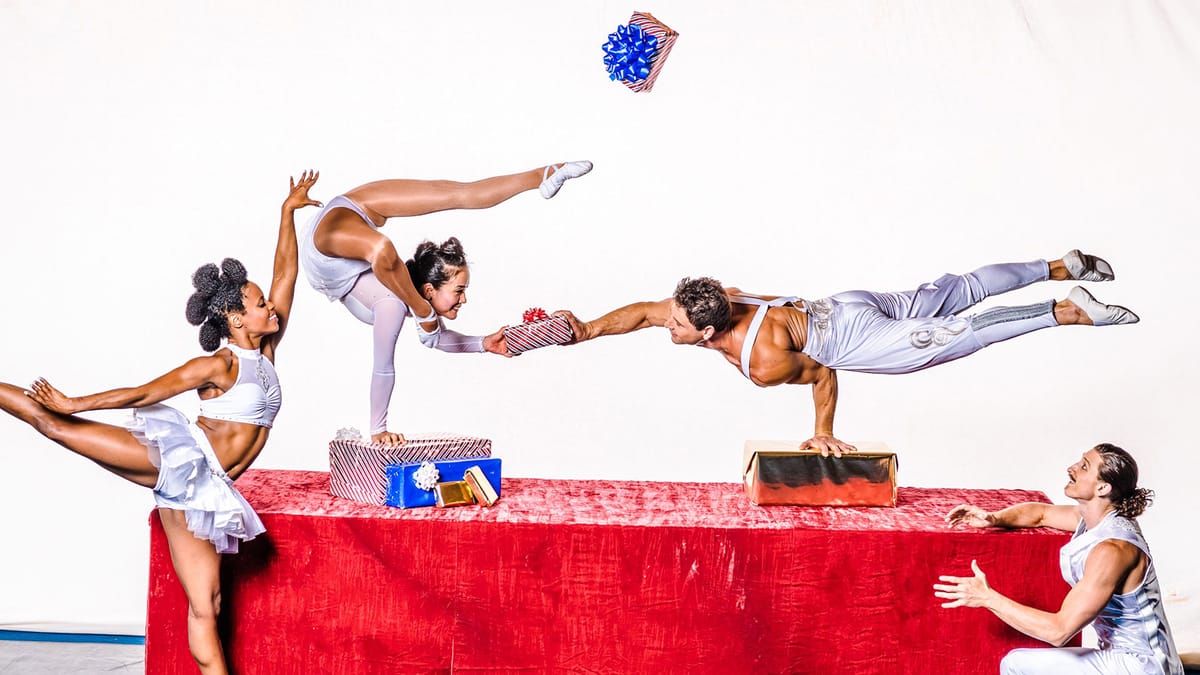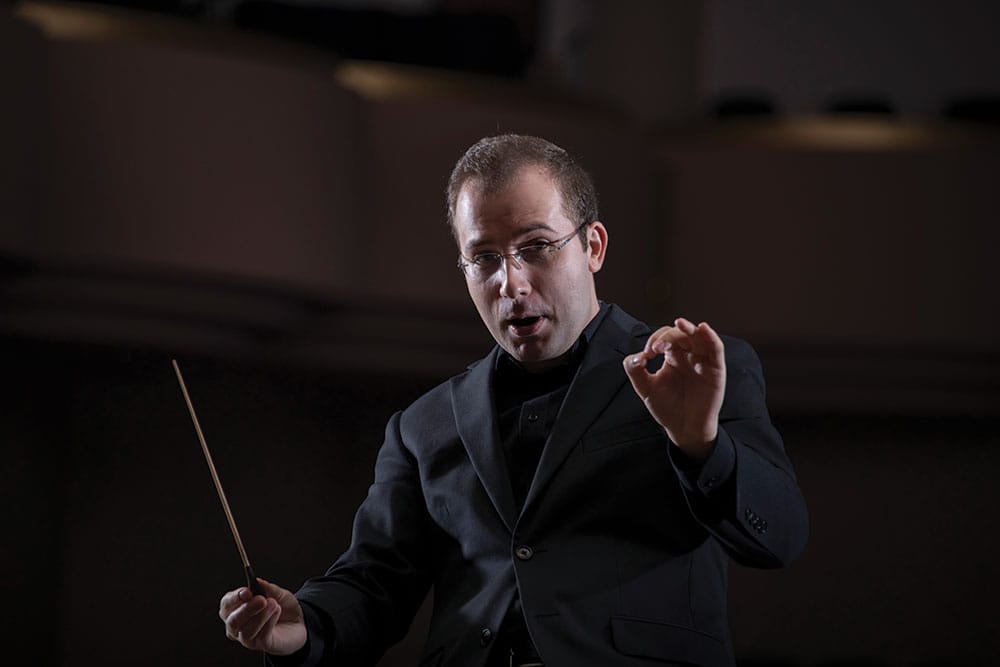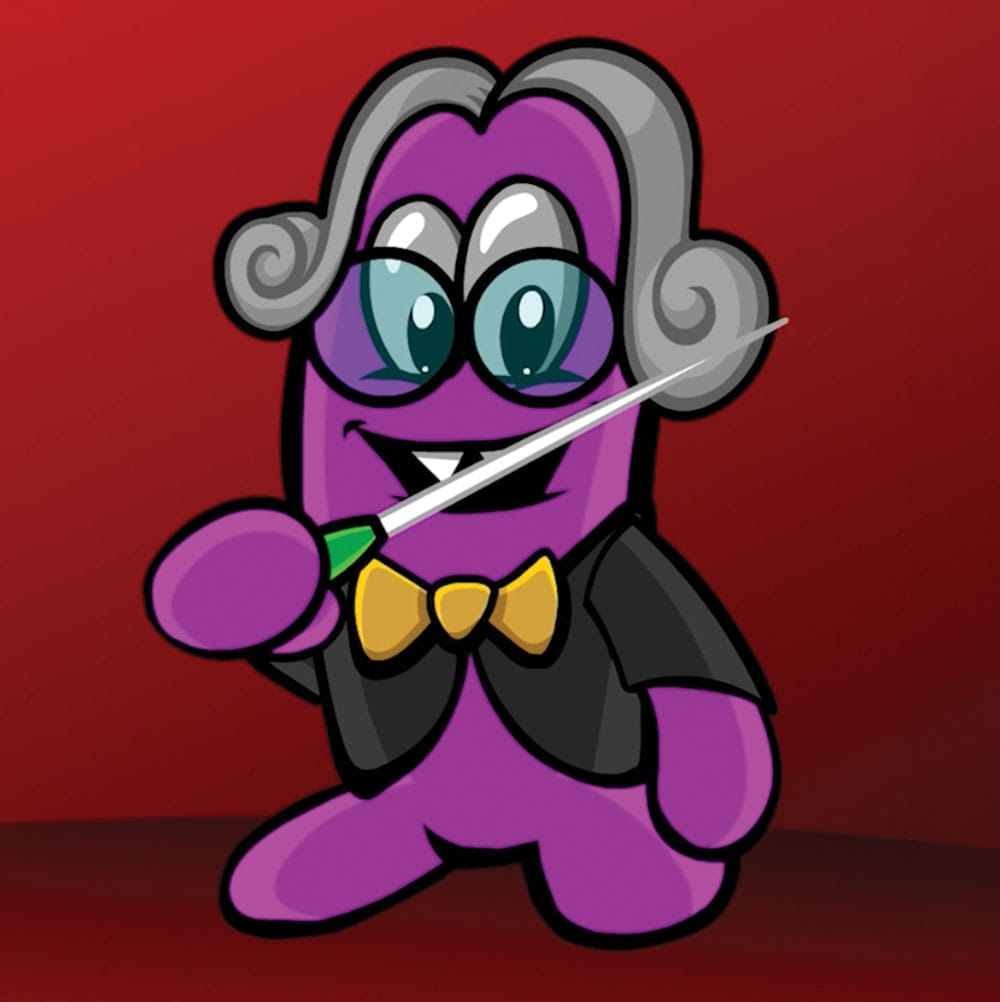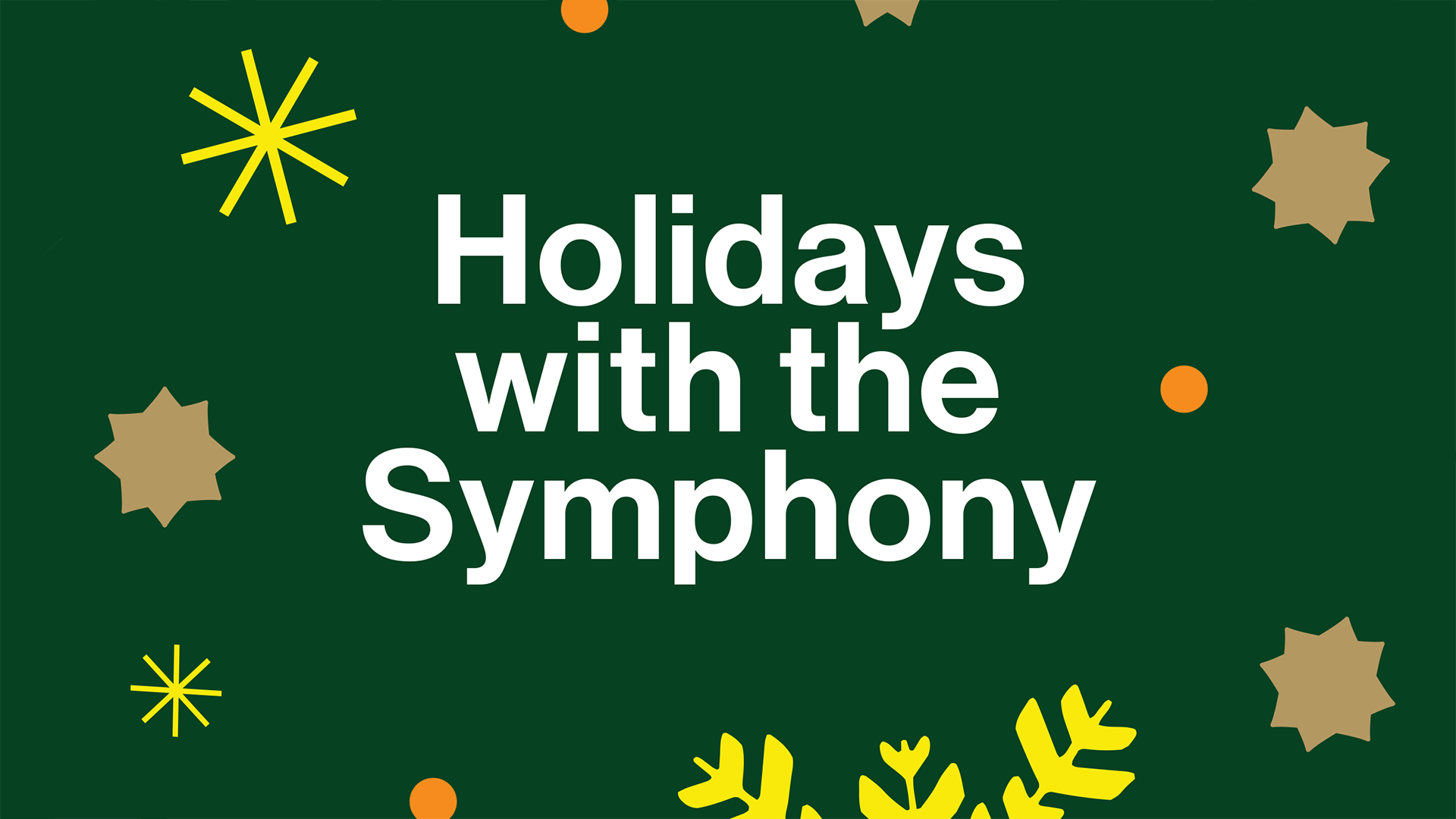In This Program
- Welcome
- Feature: Conductor and Teacher
- Announcing the New SFSKids
- Community Connections: Advocating for Real Change
- Print Edition












Welcome
One of the remarkable things about an orchestra is its ability to collaborate with artists across various mediums. We are always eager to explore opportunities that push the San Francisco Symphony in fresh, exciting directions.
This December, our concerts exemplify the range of these collaborations and showcase the incredible versatility of our musicians. You’ll witness the Symphony team up with high-flying Cirque performers in Holiday Cirque (December 2), expanding the realm of what’s possible on our Davies Symphony Hall stage. The annual Deck the Hall concert (December 8) unites the Orchestra with dancers, singers, acrobats, and choruses for a festive, family-friendly holiday celebration. Co-hosted by Edwin Outwater and Peaches Christ, Holiday Gaiety (December 13) brings together the Symphony and dynamic performers from the worlds of drag, cabaret, and theater for a spirited evening.
We’re also thrilled to collaborate with pop luminaries in Colors of Christmas (December 3–4) and Holidays with Boyz II Men (December 17–18). And we continue to expand our film with live orchestra series with performances of The Muppet Christmas Carol (December 12 & 14) and Elf (December 19–21).
Our holiday season also highlights two of the Symphony’s outstanding ensembles: The SF Symphony Youth Orchestra, under new director Radu Paponiu, presents its annual performance of Peter and the Wolf (December 15), while our amazing SF Symphony Chorus joins the Orchestra and leading lights of the early music world for performances of Handel’s Messiah (December 6–7). And don’t miss our extraordinary brass and percussion musicians in Holiday Brass (December 11).
December is one of the busiest times for the Symphony, yet we are continually energized by the amazing collaborations that come to life on our stage. We look forward to welcoming you to Davies Symphony Hall and are honored to be part of your holiday celebrations.
Priscilla B. Geeslin
Chair, San Francisco Symphony

Conductor and Teacher
Radu Paponiu joins the SF Symphony Youth Orchestra • By Benjamin Pesetsky
ON A SATURDAY AFTERNOON in early October, the San Francisco Symphony Youth Orchestra convened for their third rehearsal of the season. Radu Paponiu, the YO’s newly appointed Wattis Foundation Music Director, took the Davies Symphony Hall stage with Harry Jo, a high-school violinist who won the 2023–24 Concerto Competition on his second instrument, alto saxophone. At the downbeat, they ripped into Takashi Yoshimatsu’s Cyber Bird Concerto, a jazz-influenced Japanese work from 1994. The saxophone, brilliant and a bit cheeky, wove over a rapid drumbeat laid down by the percussion section. The strings joined in a swell, responding to the soloist’s lines, and sharp piano chords urged it all along. After an impressive read-through, Paponiu flipped back to work on the very first note.
“No hesitation! All together!” he tells the double basses, who ground the first bar with a low pizzicato C. What first sounded like a racket of notes comes together as a collective snap on the second try. Then Paponiu turns to a cacophonous, free-jazz section that asks members of the orchestra to improvise. He works through it until the crescendo takes the right climactic shape.
After a break, the YO turns to an older, more familiar piece—Tchaikovsky’s Symphony No. 4. “D natural! Nothing else!” Paponiu reminds the players as they tune a chord. Then he talks briefly about the piece’s history and how it should be felt. “We know from Tchaikovsky’s letter that this is about anxiety,” Paponiu says. “This is tense.” In 1878 Tchaikovsky wrote a letter to his patron describing the Symphony’s theme as “the sword of Damocles over our heads.” The young musicians play the opening again, more focused this time on the composer’s emotional intent.
For the last half hour of this special rehearsal, parents are invited into the hall to hear a preview of what the orchestra has been working on. Though more than a month of rehearsals remain before the first concert, the YO already gives a polished take on Tchaikovsky’s finale and Bernstein’s Overture to Candide. Parents watching closely might have noticed Jacob Nissly, the SF Symphony’s Principal Percussion, hovering in the back, advising a triangle-player. Several other Symphony musicians who serve as coaches for the YO could be spotted on stage and in the audience—a superabundance of expert mentors that music students hardly get anywhere else.
Founded in 1981, the SFSYO offers tuition-free training to more than 100 young musicians (ages 12–21) from across the Bay Area; its ranks are filled each year through competitive auditions. Many go on to professional careers—five members of the SF Symphony are even alumni. The SFSYO’s first Music Director was Jahja Ling, followed by David Milnes, Leif Bjaland, Alasdair Neale, Edwin Outwater, Benjamin Shwartz, Donato Cabrera, Christian Reif, Daniel Stewart, and now Radu Paponiu, who has been appointed to a three-year term.
Paponiu hails from Romania, where he began playing violin at age seven. He first came to the United States in 2007 to join the Perlman Music Program near Long Island, and later studied violin at the Colburn School in Los Angeles and conducting at New England Conservatory in Boston. Most recently, he served as associate conductor of the Naples Philharmonic in Florida and music director of the Naples Philharmonic Youth Orchestra. He has also been music director of the Southwest Florida Symphony, a member of the conducting faculty at the Juilliard Pre-College, and has guest conducted in Europe and America. His wife, Blair Francis Paponiu, is the SF Symphony’s Associate Principal Flute, holding the Catherine & Russell Clark Chair. They met in Naples, where she played before joining the SF Symphony in 2023.
Backstage at the end of rehearsal, Paponiu sat down for an interview.
What are your first impressions of the SFSYO?
Already I feel that when you have this kind of talent, there really is no ceiling to what we can achieve. Each week I can’t wait for the next rehearsal to see how much further we will get.
Did you grow up playing in youth orchestras yourself?
I’m from a small town in Romania, but we had an art school with both painting and music. When I was nine, I joined the string orchestra there. I still remember being so excited, going to the first rehearsal, playing the first bar, and then being lost the rest of the time! But it was a huge inspiration because I loved the idea of not just practicing by myself, but going and playing with others. At 12 I moved to Bucharest to attend the George Enescu Music High School, and I played in the Central European Initiative Youth Orchestra each summer. Students from across the region would get together, rehearse for two weeks, and then tour Europe. While I was in college, I played in the American Youth Symphony in LA and was also an assistant conductor there. As it turns out, I’ve always been involved in a youth orchestra program, whether playing, coaching, or conducting.
What drew you to conducting?
I always loved the idea of studying the score and perhaps discovering something new. To this day, I find it so exciting to deal with some of the greatest works of art that humanity has created. Every time you open a score, there’s something to see. And then whatever you learn, you can go and share with others.
How exactly does a conductor study a score?
Every conductor has a different way, and it changes with time, because once you become familiar with a piece, it’s very different when you return to it. I was fortunate to play a lot of pieces on the violin before conducting them. But I do have a process of phrase analysis where I try to get into the composer’s mind and understand how the piece is built. I think harmony is ultimately what gives the form. Then I ask, what did the composer really want to say? And what do I want to say?
Do you encourage students look at the full score? How should they approach it?
This is where the fun begins! It’s not just learning your own part, but seeing how it fits with everyone else. Any sort of studying, you cannot go wrong. That’s how I learned—just being every day in the score, asking questions. First, find your instrument and try to follow along. Then ask, is anyone playing the same line with me? You’ll get a glimpse into what the composer was thinking.
As a string player, how did you learn to work with students who play other kinds of instruments?
Ever since I started, I’ve tried to say yes to every single thing I was asked to conduct. So I’ve gotten to work with woodwinds, contemporary groups with lots of percussion, and brass ensembles. It takes a lot of work to get that experience, but it’s the most helpful way to learn about instruments and how to address their particular issues. And of course, the SFSYO has incredible access to the musicians of the San Francisco Symphony, and that makes a huge, huge difference!
How do you choose what pieces to play with the YO?
I like to have a path every year. Program to program, I’m thinking about difficulty and how it can increase a little bit. I also want to work on ensemble technique and listening, so I try to think of music that is really going to force us to do that. I think it’s very important to have a progression throughout the season, and to start with repertoire that can teach a lot.
What are the biggest benefits of playing in a youth orchestra?
I really think it’s one of the most amazing experiences you can have. It teaches you things that apply in everything you do. You need to have the responsibility and discipline to practice the music, and then bring it to rehearsal and create a positive experience for everybody. You really learn to work with others—sometimes you might love a musical idea and be happy to do it, and sometimes maybe you’d prefer to play it a little bit differently. But you have to try it both ways, and many times you’ll change your mind and see it from a new angle.

Announcing the New SFSKids
The San Francisco Symphony has launched the next generation of its award-winning, free online music education resource, SFSKids.org.
The new website, which was created by Rolling Orange and features artwork and animations by Bay Area artist Jesse Hernandez, is designed to be a fun online music education resource for children ages 8–13. Students can use the website for self-directed learning, while teachers or parents can utilize it for group learning in the classroom, homework assignments, or cooperative learning projects.
SFSKids.org is accessible on desktop and mobile devices and is intended as a resource to support several of the learning targets outlined in music standards documents at national, state, and local levels. Active listening, responding to music, developing personal preferences, fostering awareness of the expressive characteristics in music, creating music, and making creative decisions about music are some of the music content areas the website supports.
The original SFSKids.org launched in March 2002 as one of the first music websites for children. The Symphony unveiled the second generation of the website in 2014. Since its debut, the site has reached more than five million users. The current SFSKids.org—the third iteration of the site—features an updated design and content to engage a new generation of users.
Lead sponsorship for SFSKids.org was provided by the Sakurako & William Fisher Family.

Community Connections
Advocating for Real Change
Sometimes, those closest to a problem are closest to its solution. That’s why the San Francisco Marin Food Bank partnered with neighbors who’ve experienced hunger to form the grassroots Food Policy and Advocacy Coalition (Food PAC).
Meet Greer, a single mother, student, and Marin resident who’s faced food insecurity throughout her life. When she joined the group, Greer identified CalFresh (formerly food stamps) as needing change. “When your benefits get messed up because of a paperwork issue or a change in caseworker, it impacts you in a lot of ways,” she shared. “I’ve had to take days off work, leave my child at childcare longer. It adds so much stress to your life.”
CalFresh is one of the most effective tools for ending hunger, but improvement is needed, including expanding enrollment of eligible people who don’t receive benefits. That’s why the Food Bank helped lead advocacy efforts to pass AB 518. The bill requires California to develop ways to identify those eligible but not participating in CalFresh and take culturally appropriate steps to enroll them.
There is more to do and becoming an advocate is motivating for Greer. “Having to utilize food banks in different ways throughout my life, I want to be able to help and give back in whatever way I can.”
Learn more at sfmfoodbank.org.
Print Edition
















